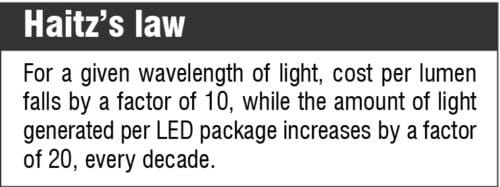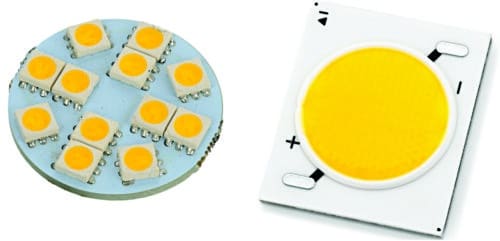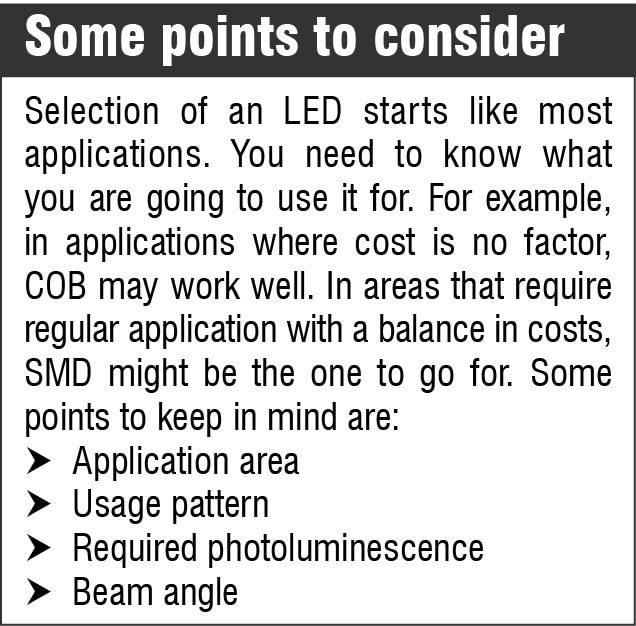Ever wondered about the size of a salt grain? A single salt grain measures about three mil, which is a thousandth of an inch. Now, imagine a third of that size, placed on a printed circuit board (PCB). That is the size of the smallest LED available today. People do not regularly go for it, but it is heartening to know that something that small can also brighten something up.
That is where the surface-mount device light-emitting diode (SMD LED) module comes into the picture. Now, you have a 0.65mm×0.35mm×0.2mm-size LED on a PCB that can be used for a range of different purposes. Wide viewing angles of about 145° and low power consumption add to the charm.
SMD is going strong
An SMD chip is created from layers of man-made nano-sapphire and gallium crystal substrates. After growing these crystals, these are sliced, layered and bonded to a ceramic base. The chip can be then mounted in the required application. Applications of an SMD include everything from light bulbs to strip lights. One interesting use case would be the indicators on mobile phones.
Over the years, SMD LED has continued to improve its luminescence in accordance with Haitz law. Unlike typical LEDs, SMD chips can have two, four or six contacts, depending on the number of diodes on the chip that may produce multiple colours. If a chip includes red, green and blue diodes, you have the possibility of creating any colour you want. This has resulted in SMDs becoming the prime choice for DC power applications, mostly due to the ease of use.

COB is another option
A COB LED has great advantages of thermal resistance, larger cooling area, better lighting effect and high light efficacy. It is basically an LED built directly on the circuit board. P. Chow Reddy, managing director, Interleaved Technologies, explains, “A COB contains multiple chips within one large wafer. This allows a larger light output and a more even spread of light.” It allows connection of the bare chip to the substrate by conductive or non-conductive adhesive and wire bonding to achieve its electrical connection. Due to fewer components in the LED chip, thermal conductivity is directed at the circuit board and without the traditional LED chip packaging structure.
Heat emissions from LED chips are on average 25 per cent lower as compared to conventional LEDs, resulting in high efficiency and lower failure rates. And since the chip is built directly onto the circuit board, it reduces the need for spot soldering. After all, fewer soldering points mean less chances of failure.
Need for traditional LED packaging parts and PC lenses has also reduced, resulting in an increase in light visibility range and a decrease in light loss from lenses. COB LEDs are generally larger than SMDs and range from a few millimetres to a few centimetres-square. At this small size, soldering these to the board becomes a problem.

COBs are easier to place on a board. The pins in SMD require precision soldering
MCOBs, a variant
An evolution over the conventional COB is the multi-chip-on-board (MCOB), for when one is not enough. It consists of multiple chips integrated into one larger single board. Assembly is cheaper compared to multiple single chips, making these suitable for applications in streetlights and high-bay lights. However, there is still some time before these can be used in smaller applications.
Sharp Devices, Europe, recently announced a range of high-performance mini and mega zenigata COB LEDs with greater efficiency and enhanced hot lumen performance. HD6 mini zenigata are 12mm×15mm with an 8mm light-emitting surface with 2500 lumens. BF6 series mega zenigata are sized at 20mm×24mm substrate with 15mm light-emitting surface.
Recently released are another two new blue LED chips from Light Avenue in 12V and 24V. Both solutions are sized at 140 mil to increase implementation in tracklights or high-bay lighting.
Small-sized chips are clustered and packaged into a light bulb that is advertised as ‘lighting always’ or ‘save power now.’ Some LED manufacturers are able to reach 249 lumens per watt with a 20mA supply. However, this is not the story with bigger sizes. Light efficiency follows an inverse relation with chip size. Additionally, with an increase in current to the LED, efficiency is further reduced.
The DIP status
One of the best things with the use of SMD and COB LEDs is that now you can get a much better looking LED display without having to pay as much for it—this brings in the matter of dual-in-line package (DIP) LEDs going out of fashion. DIPs have been around for more than 50 years, and are likely what you think of when you picture an LED. Though easy to use, these are much less efficient over other available options, and hence the reduced usage.
These typically produce about three to four lumens per LED, and individually pull between 0.05 to 0.08 watts, generating somewhere between 35 to 80 lumens per watt, depending on the actual LED. DIPs, in general, do not allow manipulation while manufacturing and are not too versatile.

Advantages with LEDs
Longer lifetime due to LEDs being solid-state sources is just one of the benefits. The average LED lasts about 50,000 to 100,000 operating hours, which is two to four times most fluorescent metal halides last, and is more than 40 times the average incandescent bulb lasts. In earlier systems, “We used incandescent bulbs in embedded systems,” says Hrishikesh Kamat, chief executive officer, Shalaka Technologies Pvt Ltd.
The problem with incandescent bulbs is that these work on AC, causing a flicker with high-speed camera recordings. “In an application, cameras were used to count the number of items on a white background, and use of incandescent bulbs was causing problems, so we switched to LEDs for lighting.” Low maintenance and low power consumption are LEDs’ other advantages.
Heat is a big concern with lighting. Traditional incandescent bulbs turn more than 90 per cent of energy directly to heat. Only 10 per cent of the energy is utilised to generate light, making these extremely inefficient. Since LEDs consume less power, these can operate effectively on low-voltage electrical systems. And LEDs are generally much safer, in case something goes wrong, adding to safety of the system.
Application areas
Application possibilities for COB LEDs encompass a wide range. While these devices could be used for higher-output general lighting, primary use of COB LEDs would be as solid-state lighting (SSL) replacements for metal-halide lamps in applications such as high-bay lighting, streetlights and high-output track lights and downlights.
Ten times increase in lighting area with COBs helps in avoiding uncomfortable glare. Hence, these could be used in study lamps, but that would be possible only after reduction in their manufacturing costs. Reddy adds, “COBs have a wider beam angle, allowing a larger area to be covered and therefore are ideal for functional lighting.”
SMDs, however, have been in business for a long time and are common among designers. Application areas range from regular LED bulbs being used in homes to indicators in electronic devices. “These are used more often in the latest general-purpose LED lighting solutions,” adds Reddy.
The wonders of light
LED lighting allows for tremendous innovation in optical effects. Tiny LED sources can be discretely integrated with creative and decorative shrouds to produce a bunch of effects. A direct-view optic can create a feeling of brilliance, whereas an indirect or grazing light effect produces a sense of heightened play of shadows and texture. A diffused luminous surface also acts as a background for graphic designs. The light itself can take on colours as warm as fire to as cool as ice. One interesting scenario could be your glass window moonlighting as an organic light source.






